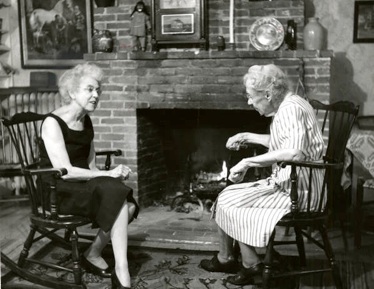helen hartness flanders

helen hartness flanders



Helen Hartness Flanders lived in the age of the ear. In that pre-video time, local news was often information passed among neighbors from one farm to another, spread at paring bees and church socials. News became verses and verses became songs.
Once fashioned, these musical records of triumphs and tragedies took on lives of their own, became in effect living entities, capable of outlasting their creators and adapting to new circumstances. Some of these were ballads that were direct descendants of songs that had traveled from Europe to the shores of the New World and then inland to settle in the inner parts of New England, where they were changed to fit the circumstances of place and time. Others were composed to mark purely New England events. Helen Flanders treasured them all.
She came upon her life's work largely by serendipity. In 1930, the Vermont Commission on Country Life asked her to collect some of the folk songs of New England. The work was funded for a year; for Flanders, the pursuit would consume much of the rest of her life. By the time she stopped collecting 30 years later, she and her long-time assistant, Marguerite Olney, had recorded or transcribed the more than 9,000 songs that are the foundation of the Helen Hartness Flanders Ballad Collection at Middlebury College.

"It's difficult to overestimate what Helen Hartness Flanders did," says Dale Cockrell, a musicologist, formerly at Middlebury, in the introduction to a program on the Flanders Collection prepared for Vermont Public Radio.
"This remarkable woman, at a time in 1930 when people were starting to fear the traditional arts in New England and Vermont were going to die out, this woman took it upon herself to spend the next 30 years of her life going through this area collecting traditional folk songs, traditional ballads, anything she could find of the traditional arts, in the process accumulating some 9,000 items That's some significant collection.
But Helen Flanders didn't simply collect the past so that it could lie, gathering dust, in the basement of a library, Instead she breathed new life into these pieces of living history, saving them from death-by-neglect so that musicians such as Margaret MacArthur could come along years later and include them in their repertories.
"If she hadn't done this, the songs would have died with the people who sang them." says MacArthur, who lives in Marlboro and knew Flanders for the last 12 years of her life. " I'm interested in the songs for their antiquity, for their local content, for the beauty of the music. This material could have been written down, but I love to listen to the old people singing them."
In saving New England songs, Helen Hartness Flanders also proved, according to Jennifer Post, that New England once had as many or more traditional singers and songs than the South, which has received much more attention from musicologists.
Helen Hartness Flanders was born in the time before information gatherers - we now call them reporters and historians - had become celebrities. There is no sense in her prolific writing that she considered herself important to the process. Rather, it was the songs and the singers she considered to be the topics of interest.
Photographs of Flanders offer, at best, small clues about her personality. With her white hair neatly in place and her rimless glasses, she looks to have been a prettier version of Eleanor Roosevelt. The Barbara Bush-style choker of pearls at her neck in one studio portrait suggests that she, like the current First Lady, was a wealthy Republican which, in fact, she was.
Helen Hartness was born in Springfield on May 19, 1890, the daughter of James and Lena Hartness. Her father, an inventor and engineer, would later become president of the Jones and Lamson Machine Co., one of the handful of machine-tool companies that formed the backbone of the Connecticut River Valley economy. He served as governor of Vermont from 1921-23.
One of James Hartness' close friends was an ambitious young mechanical engineer and businessman named Ralph Flanders, who worked for the rival Fellows Gear Shaper Company. The young man became a frequent visitor at the Hartness home, in part because of daughter Helen. He was attracted by her brains as well as her beauty.
"We talked about literature and discussed the latest Times book review," Flanders recalled in his
autobiography, Senator from Vermont. "We talked about music. She delighted me with her musicianship at
the piano. She had had and was having the best training available in Boston from Heinrich Gebhard, who was later to give lessons to Leonard Bernstein."
Helen Hartness married Ralph Flanders on November 1, 1911 in the living room of Smiley Manse, the Hartness family home.
Flanders went to work for his father in law at Jones and Lamson. Elizabeth Flanders was born in 1912, followed by Nancy in 1918 and James in 1923. Ralph Flanders was elected to the U.S. Senate in 1946 and became famous as the first senator to challenge Wisconsin's Sen. Joseph McCarthy on his anti-communist crusade.
Helen Flanders' career as a pianist was ended early by arthritis, but in 1930 her career as a collector was only beginning. The year before, the State of Vermont had created the Commission on Country Life. At that time, there widespread interest around the country in collecting folk music and ballads. Much of the collecting was being done in Appalachia and much of it was under the supervision of Phillips Barry, a Harvard musicologist. Barry's particular interest was Child ballads named after Francis Child, a 19th century musicologist who had collected 305 ballads from the British and Scottish traditions.
A subgroup of the commission, the Committee on Traditions and Ideals was headed by Arthur Wallace Peach, a professor at Norwich University. It was Dr. Peach who proposed to Mrs. Flanders that she spend a year collecting music on the back roads of Vermont. The committee money soon ran out just as Flanders began to have an inkling of how much music was out there. She continued anyway, on her own and without payment except for the personal satisfaction she obviously got from her work. That one year extended into three decades; that small project became her life's work. And she did not limit herself to Vermont, but tracked down singers and collected songs all over New England.
In 1935, Helen Flanders met Marguerite Olney, a woman who would become very nearly as important to the Flanders Collection as Flanders herself. Olney was a graduate of the New England Conservatory of Music and particularly skillful at transcribing the songs she heard.
"A lot of the credit should go to Marguerite Olney," notes Margaret MacArthur. "She was a big part of it and she did a lot of the collecting."
In later years, the two women would have a serious falling out for reasons never explained publicly, although some speculate that Marguerite Olney resented how little credit she earned for her efforts. She became a recluse and died in a house fire.
But in the happier early days, Flanders and Olney would traipse the countryside together and separately, seeking out old songs in lumber camps and in tiny towns such as Woodbury, Danville and Cuttingsville.
At first, they used a dictaphone of the type invented by Thomas Edison. The dictaphone, on display in the basement room that houses the Flanders Collection at Middlebury, cut wax cylinders and could be run off batteries or plugged into a car's cigarette lighter if the house had no electricity, which was often the case. She later recorded directly onto aluminum, glass and acetate discs, and still later used reel-to-reel tape recorders.
More than the technology, however, it was Helen Flanders' way with people that enabled her to do what she did, charming her way into the homes of strangers, cajoling reluctant singers into performing for her. It was rare that she came away without some musical gem.
"From some 13 years of going up and down this northeastern land of ballads," Flanders wrote in one of her many articles, "Confessions of a Ballad Collector," "there are few byroads that do not have some association, few non- committal doorways which, opened by perfect strangers, have not given momentous experiences in texts and tunes."
She delighted in tracking ballads and folk songs through time and geography, recording the mutations and influences of different generations and places.
In her four-volume work Ancient Ballads Traditionally Sung in New England, she includes a version of the Child ballad entitled "The EIfin Knight," only here it has become "The Cambric Shirt." It is close cousin to the latter-day version that Simon and Garfunkel put out as "Scarborough Fair," perhaps better known as "Parsley, Sage, Rosemary and Thyme."
Similarly, she found in North Calais the tragic tale of 18 people who drowned when a boat capsized on a local lake in 1873. Among the papers of an East Berkshire family, she found an almost identical song based on the tale of five men who drowned when a longboat overturned in Mulberry, England, in 1880. Both songs had been poured into the mold of a much older ballad. Parentheses indicate the words of the Calais version:
Oh, Mulberrry (Calais) trembled (did tremble) at that awful stroke;
Consider (And considered) the voice of Jehovah that spoke.
To teach us we are (we're) mortal, and exposed to death;
And subject each moment to yield up our breath.
By the time Flanders stopped collecting in 1960 and turned her full attention to cataloging and writing about the material, she had amassed 5,000 pieces of traditional music; 4,000 letters, broadsides and manuscripts; 234 wax cylinders; 1,312 discs and 62 tapes, according to a count made by Cockrell some years ago. Since that count was made, says Flanders Collection curator Jennifer Post, new material has been added.
In addition to ballads, the collection includes British and early American songs, folk hymns, call-dances, nursery games and counting-out rhymes. There are handwritten songs from copybooks, ledgers, cookbooks, diaries and letters - treasures that came into families, writes Flanders, "by heredity or adoption."
"By heredity or adoption also," she writes, "they possessed an unwritten lore - ballads passed along orally down generations of memories. Sea battles, border frays, the super-sensitive romances, chronicles, and the like were learned 'by ear' in their tune. There are remnants of an oral tradition from the time of Skalds to the present, records of periods, people, and locales, as diverting and entertaining as foreign travel."
The great accomplishment of Helen Hartness Flanders was that she captured, validated, and maintained that rich oral tradition. She lived a long and satisfying life, and when she died in Springfield in 1972, at the age of 82, she could rest secure in the knowledge that her legacy would be an everlasting one.
Sally Johnson is editor of the Rutland Herald's Vermont Sunday Magazine, and resides in Middlebury.
reprinted by permission
A Legacy of Music
Helen Hartness Flanders Preserved Vermont's Folk Music Traditions
by Sally Johnson
Vermont Life, Spring 1991
